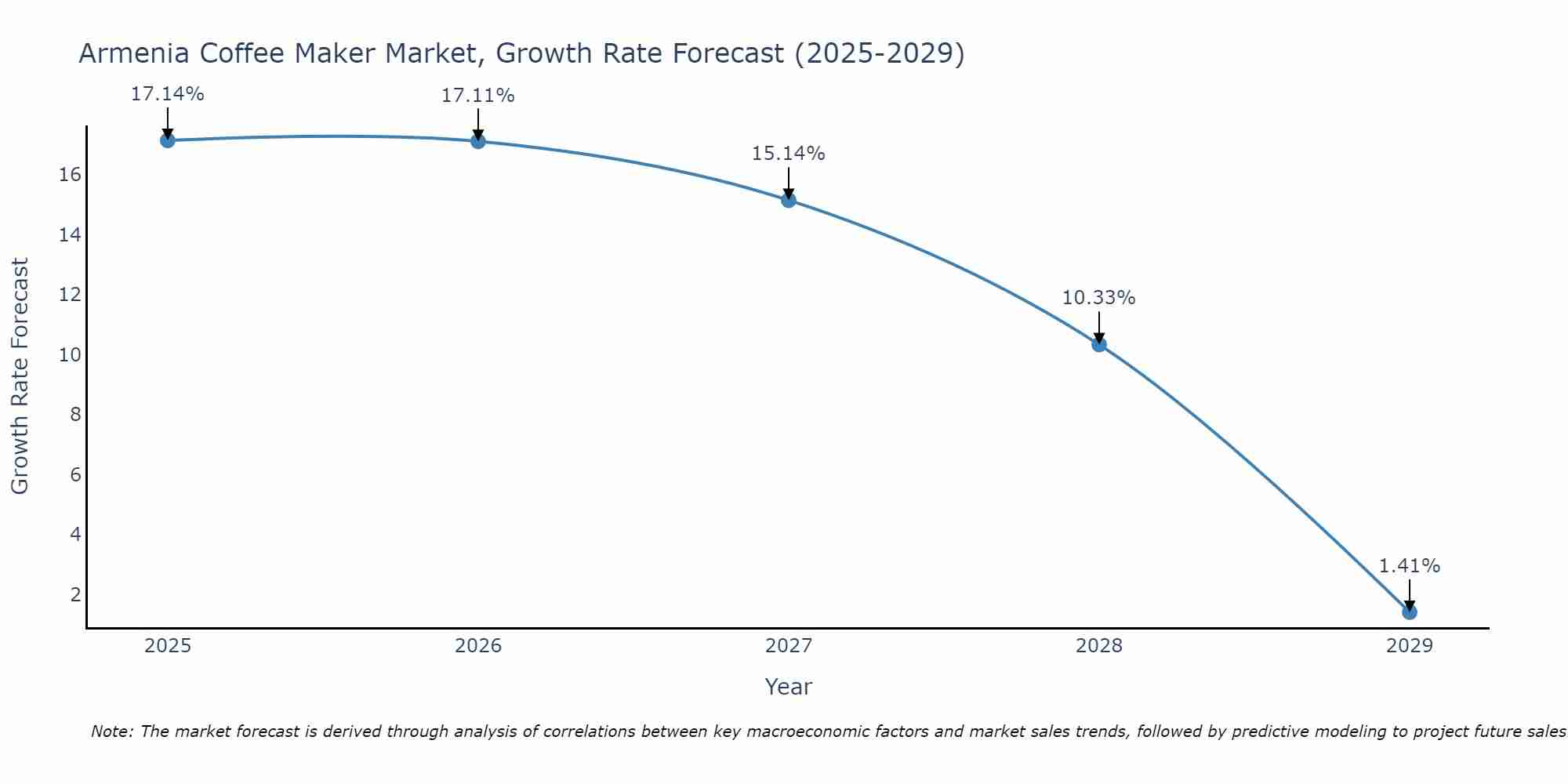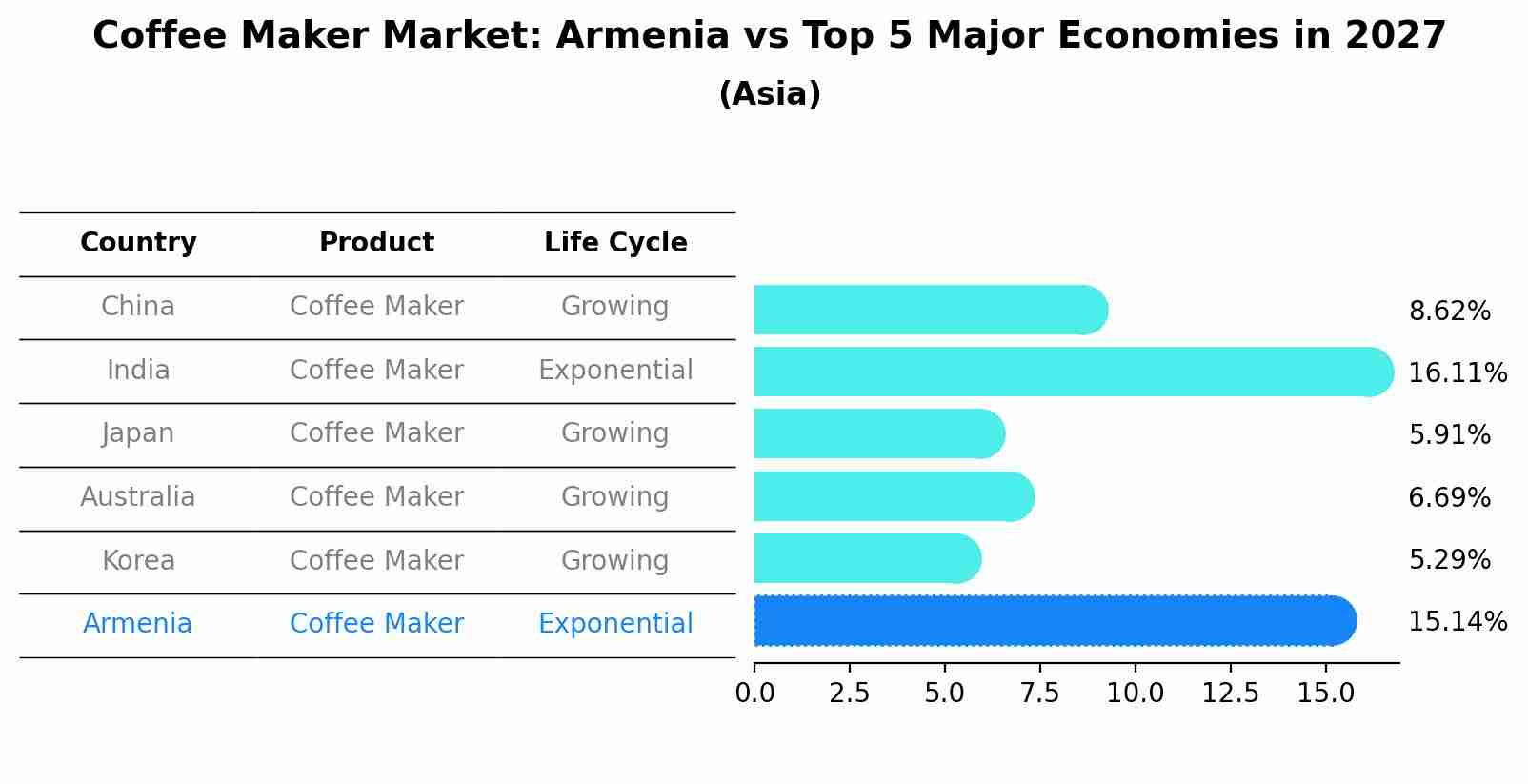Armenia Coffee Maker Market (2025-2031) | Size, Analysis, Forecast, Outlook, Trends, Revenue, Share, Growth, Value, Companies, Industry & Segmentation
| Product Code: ETC4797973 | Publication Date: Nov 2023 | Updated Date: Apr 2025 | Product Type: Market Research Report | |
| Publisher: 6Wresearch | Author: Sachin Kumar Rai | No. of Pages: 60 | No. of Figures: 30 | No. of Tables: 5 |
Armenia Coffee Maker Market Size Growth Rate
The Armenia Coffee Maker Market could see a tapering of growth rates over 2025 to 2029. Starting high at 17.14% in 2025, the market steadily declines to 1.41% by 2029.

Coffee Maker Market: Armenia vs Top 5 Major Economies in 2027 (Asia)
The Coffee Maker market in Armenia is projected to grow at a exponential growth rate of 15.14% by 2027, highlighting the country's increasing focus on advanced technologies within the Asia region, where China holds the dominant position, followed closely by India, Japan, Australia and South Korea, shaping overall regional demand.

Armenia Coffee Maker Market Overview
The Armenia coffee maker market has seen significant growth in recent years, driven by increasing consumer preference for home-brewed coffee. The market comprises various types of coffee makers, including drip coffee makers, single-serve coffee machines, and espresso machines. The trend towards premium coffee consumption and the convenience offered by modern coffee makers are key factors propelling the market. Technological advancements and product innovations also contribute to market expansion. However, the market faces challenges such as high competition from international brands and the economic impact on consumer purchasing power.
Drivers of the market
The coffee maker market in Armenia is driven by increasing urbanization and the growing trend of coffee consumption among the younger population. The rising number of cafes and coffee shops, along with a shift towards specialty coffee, has fueled the demand for advanced coffee makers. Additionally, the influence of Western culture and the increasing disposable income of the middle class contribute to market growth. The proliferation of e-commerce platforms has also made coffee makers more accessible to a wider audience, further driving the market.
Challenges of the market
The coffee maker market in Armenia faces several challenges. One significant issue is the limited market size, which restricts economies of scale for local manufacturers and increases unit production costs. Additionally, the market is dominated by international brands, making it difficult for local businesses to compete. Import tariffs and fluctuating currency exchange rates further complicate the pricing strategy for imported coffee makers. Consumer preferences are also shifting towards more convenient and technologically advanced machines, requiring constant innovation and investment in new technologies. Finally, the overall economic situation in Armenia can affect consumer spending power, limiting the potential market growth.
Government Policy of the market
The Armenia coffee maker market is influenced by various government policies aimed at promoting consumer safety, energy efficiency, and market competition. Regulations governing the manufacturing, importation, and sale of coffee makers ensure compliance with quality standards and environmental norms. Additionally, initiatives supporting small businesses and entrepreneurship play a crucial role in fostering growth within this market segment.
Key Highlights of the Report:
- Armenia Coffee Maker Market Outlook
- Market Size of Armenia Coffee Maker Market, 2024
- Forecast of Armenia Coffee Maker Market, 2031
- Historical Data and Forecast of Armenia Coffee Maker Revenues & Volume for the Period 2021-2031
- Armenia Coffee Maker Market Trend Evolution
- Armenia Coffee Maker Market Drivers and Challenges
- Armenia Coffee Maker Price Trends
- Armenia Coffee Maker Porter`s Five Forces
- Armenia Coffee Maker Industry Life Cycle
- Historical Data and Forecast of Armenia Coffee Maker Market Revenues & Volume By Types for the Period 2021-2031
- Historical Data and Forecast of Armenia Coffee Maker Market Revenues & Volume By Drip Coffee Machine for the Period 2021-2031
- Historical Data and Forecast of Armenia Coffee Maker Market Revenues & Volume By Steam Coffee Machine for the Period 2021-2031
- Historical Data and Forecast of Armenia Coffee Maker Market Revenues & Volume By Capsule Coffee Machine for the Period 2021-2031
- Historical Data and Forecast of Armenia Coffee Maker Market Revenues & Volume By Others for the Period 2021-2031
- Historical Data and Forecast of Armenia Coffee Maker Market Revenues & Volume By End-users for the Period 2021-2031
- Historical Data and Forecast of Armenia Coffee Maker Market Revenues & Volume By Commercial for the Period 2021-2031
- Historical Data and Forecast of Armenia Coffee Maker Market Revenues & Volume By Industrial for the Period 2021-2031
- Historical Data and Forecast of Armenia Coffee Maker Market Revenues & Volume By Distribution Channel for the Period 2021-2031
- Historical Data and Forecast of Armenia Coffee Maker Market Revenues & Volume By Online for the Period 2021-2031
- Historical Data and Forecast of Armenia Coffee Maker Market Revenues & Volume By Offline for the Period 2021-2031
- Armenia Coffee Maker Import Export Trade Statistics
- Market Opportunity Assessment By Types
- Market Opportunity Assessment By End-users
- Market Opportunity Assessment By Distribution Channel
- Armenia Coffee Maker Top Companies Market Share
- Armenia Coffee Maker Competitive Benchmarking By Technical and Operational Parameters
- Armenia Coffee Maker Company Profiles
- Armenia Coffee Maker Key Strategic Recommendations
Frequently Asked Questions About the Market Study (FAQs):
1 Executive Summary |
2 Introduction |
2.1 Key Highlights of the Report |
2.2 Report Description |
2.3 Market Scope & Segmentation |
2.4 Research Methodology |
2.5 Assumptions |
3 Armenia Coffee Maker Market Overview |
3.1 Armenia Country Macro Economic Indicators |
3.2 Armenia Coffee Maker Market Revenues & Volume, 2021 & 2031F |
3.3 Armenia Coffee Maker Market - Industry Life Cycle |
3.4 Armenia Coffee Maker Market - Porter's Five Forces |
3.5 Armenia Coffee Maker Market Revenues & Volume Share Segmentations, 2021 & 2031F |
3.6 Armenia Coffee Maker Market Revenues & Volume Share, By End-users, 2021 & 2031F |
3.7 Armenia Coffee Maker Market Revenues & Volume Share, By Distribution Channel, 2021 & 2031F |
4 Armenia Coffee Maker Market Dynamics |
4.1 Impact Analysis |
4.2 Market Drivers |
4.3 Market Restraints |
5 Armenia Coffee Maker Market Trends |
6 Armenia Coffee Maker Market Segmentations |
6.1 Armenia Coffee Maker Market Segmentations |
6.1.1 Overview and Analysis |
6.1.2 Armenia Coffee Maker Market Revenues & Volume, By Drip Coffee Machine, 2021-2031F |
6.1.3 Armenia Coffee Maker Market Revenues & Volume, By Steam Coffee Machine, 2021-2031F |
6.1.4 Armenia Coffee Maker Market Revenues & Volume, By Capsule Coffee Machine, 2021-2031F |
6.1.5 Armenia Coffee Maker Market Revenues & Volume, By Others, 2021-2031F |
6.2 Armenia Coffee Maker Market, By End-users |
6.2.1 Overview and Analysis |
6.2.2 Armenia Coffee Maker Market Revenues & Volume, By Commercial, 2021-2031F |
6.2.3 Armenia Coffee Maker Market Revenues & Volume, By Industrial, 2021-2031F |
6.3 Armenia Coffee Maker Market, By Distribution Channel |
6.3.1 Overview and Analysis |
6.3.2 Armenia Coffee Maker Market Revenues & Volume, By Online, 2021-2031F |
6.3.3 Armenia Coffee Maker Market Revenues & Volume, By Offline, 2021-2031F |
7 Armenia Coffee Maker Market Import-Export Trade Statistics |
7.1 Armenia Coffee Maker Market Export to Major Countries |
7.2 Armenia Coffee Maker Market Imports from Major Countries |
8 Armenia Coffee Maker Market Key Performance Indicators |
9 Armenia Coffee Maker Market - Opportunity Assessment |
9.1 Armenia Coffee Maker Market Opportunity Assessment Segmentations, 2021 & 2031F |
9.2 Armenia Coffee Maker Market Opportunity Assessment, By End-users, 2021 & 2031F |
9.3 Armenia Coffee Maker Market Opportunity Assessment, By Distribution Channel, 2021 & 2031F |
10 Armenia Coffee Maker Market - Competitive Landscape |
10.1 Armenia Coffee Maker Market Revenue Share, By Companies, 2024 |
10.2 Armenia Coffee Maker Market Competitive Benchmarking, By Operating and Technical Parameters |
11 Company Profiles |
12 Recommendations | 13 Disclaimer |
- Single User License$ 1,995
- Department License$ 2,400
- Site License$ 3,120
- Global License$ 3,795
Search
Thought Leadership and Analyst Meet
Our Clients
Related Reports
- Germany Breakfast Food Market (2026-2032) | Industry, Share, Growth, Size, Companies, Value, Analysis, Revenue, Trends, Forecast & Outlook
- Australia Briquette Market (2025-2031) | Growth, Size, Revenue, Forecast, Analysis, Trends, Value, Share, Industry & Companies
- Vietnam System Integrator Market (2025-2031) | Size, Companies, Analysis, Industry, Value, Forecast, Growth, Trends, Revenue & Share
- ASEAN and Thailand Brain Health Supplements Market (2025-2031) | Strategy, Consumer Insights, Analysis, Investment Trends, Opportunities, Growth, Size, Share, Industry, Revenue, Segments, Value, Segmentation, Supply, Forecast, Restraints, Outlook, Competition, Drivers, Trends, Demand, Pricing Analysis, Competitive, Strategic Insights, Companies, Challenges
- ASEAN Bearings Market (2025-2031) | Strategy, Consumer Insights, Analysis, Investment Trends, Opportunities, Growth, Size, Share, Industry, Revenue, Segments, Value, Segmentation, Supply, Forecast, Restraints, Outlook, Competition, Drivers, Trends, Demand, Pricing Analysis, Competitive, Strategic Insights, Companies, Challenges
- Europe Flooring Market (2025-2031) | Outlook, Share, Industry, Trends, Forecast, Companies, Revenue, Size, Analysis, Growth & Value
- Saudi Arabia Manlift Market (2025-2031) | Outlook, Size, Growth, Trends, Companies, Industry, Revenue, Value, Share, Forecast & Analysis
- Uganda Excavator, Crane, and Wheel Loaders Market (2025-2031) | Strategy, Consumer Insights, Analysis, Investment Trends, Opportunities, Growth, Size, Share, Industry, Revenue, Segments, Value, Segmentation, Supply, Forecast, Restraints, Outlook, Competition, Drivers, Trends, Demand, Pricing Analysis, Competitive, Strategic Insights, Companies, Challenges
- Rwanda Excavator, Crane, and Wheel Loaders Market (2025-2031) | Strategy, Consumer Insights, Analysis, Investment Trends, Opportunities, Growth, Size, Share, Industry, Revenue, Segments, Value, Segmentation, Supply, Forecast, Restraints, Outlook, Competition, Drivers, Trends, Demand, Pricing Analysis, Competitive, Strategic Insights, Companies, Challenges
- Kenya Excavator, Crane, and Wheel Loaders Market (2025-2031) | Strategy, Consumer Insights, Analysis, Investment Trends, Opportunities, Growth, Size, Share, Industry, Revenue, Segments, Value, Segmentation, Supply, Forecast, Restraints, Outlook, Competition, Drivers, Trends, Demand, Pricing Analysis, Competitive, Strategic Insights, Companies, Challenges
Industry Events and Analyst Meet
Whitepaper
- Middle East & Africa Commercial Security Market Click here to view more.
- Middle East & Africa Fire Safety Systems & Equipment Market Click here to view more.
- GCC Drone Market Click here to view more.
- Middle East Lighting Fixture Market Click here to view more.
- GCC Physical & Perimeter Security Market Click here to view more.
6WResearch In News
- Doha a strategic location for EV manufacturing hub: IPA Qatar
- Demand for luxury TVs surging in the GCC, says Samsung
- Empowering Growth: The Thriving Journey of Bangladesh’s Cable Industry
- Demand for luxury TVs surging in the GCC, says Samsung
- Video call with a traditional healer? Once unthinkable, it’s now common in South Africa
- Intelligent Buildings To Smooth GCC’s Path To Net Zero


















